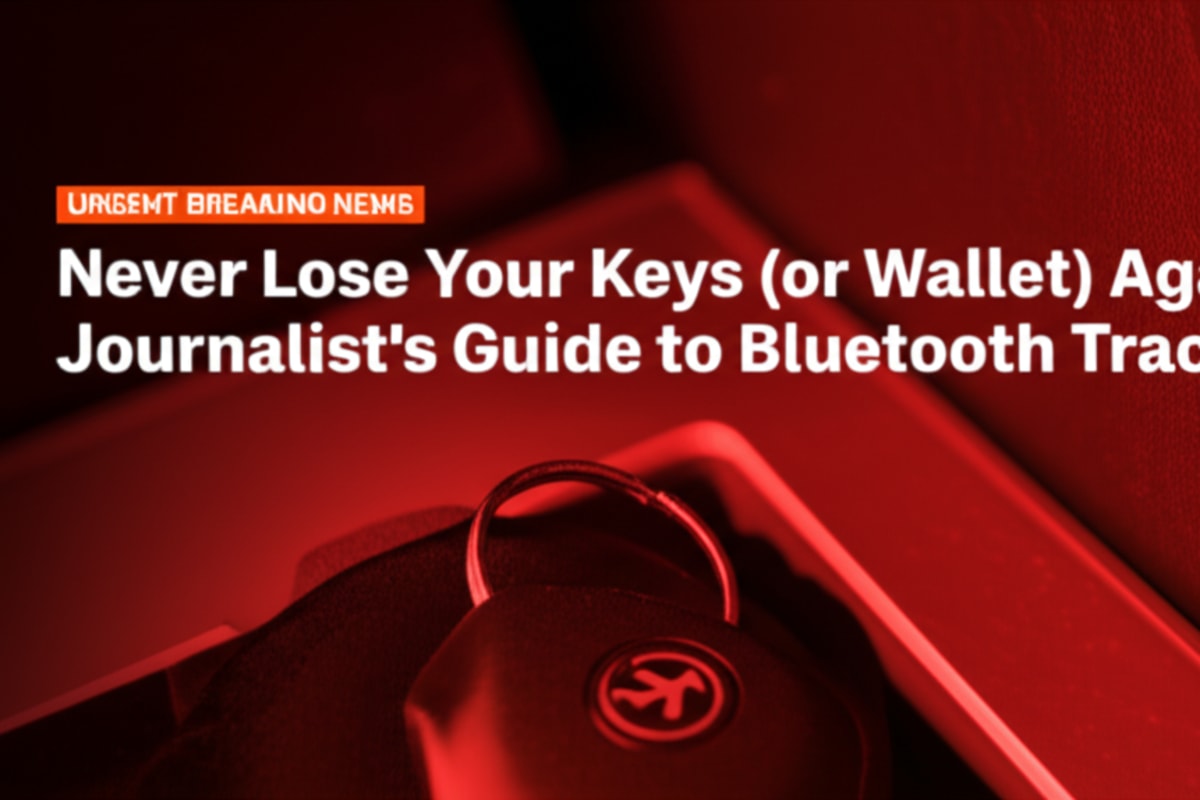Never Lose Your Keys (or Wallet) Again: A Journalist's Guide to Bluetooth Trackers

Tired of the Daily Scramble. Bluetooth Trackers Are Your New Best FriendLet's be honest: some people are just *lucky*.
Background
Their wallets are always where they left them, keys never play hide-and-seek, and the TV remote. Always on the coffee table.
Then there's the rest of us – the perpetually scrambling, muttering-under-our-breath crowd who could swear that item was *just right here* a second ago
For us, my friends, there are Bluetooth trackers, and let me tell you, they've come a long, long way
These tiny tech saviors have been around for a while, and the basic premise is simple: stick one on an object, pair it with your phone, and if it vanishes, you can usually make it ring from an app
But today's trackers are far more sophisticated
We're talking ultra-wideband (UWB) chips for pinpoint accuracy – so you can find exactly which couch cushion your remote devoured.
Crucially, they're also tapping into massive, ubiquitous networks like Apple's Find My and Google's Find Hub, dramatically expanding their reach far beyond your home
Many will even ping you if you've left something behind, or sport QR codes that link directly to your contact info, making it easy for a good Samaritan to return your lost item
Now, these incredible features aren't without their complexities
Remember when AirTags first launched. Apple hadn't quite foreseen them being repurposed to track people or stolen goods.
To their credit, companies like Apple and Tile have since significantly beefed up their anti-stalking measures.
Apple and Google even launched a joint standard this year to ensure unwanted tracking alerts work across both iOS and Android – a massive step forward, with major players like Tile, Samsung, and Chipolo jumping on board
Still, until this universal standard is fully rolled out, it pays to understand each tracker's individual approach.
As a self-proclaimed, consummate Loser of Things (my family can attest), I’ve put countless Bluetooth trackers through their paces on everything from wallets and keys to luggage disappearing into the abyss of airport carousels
Here’s what I’d recommend if you, too, spend a good chunk of your life playing hide-and-seek with your belongings.
The Gold Standard for iPhone Users: Apple AirTagWhen Apple dropped AirTags in 2021, they didn't just join the category; they *shook it up*
Because AirTags marry Apple's Ultra Wideband (UWB) chip with its colossal Find My network. That's a potent, almost magical, combination.
Even though you can now find third-party trackers compatible with the Find My network (like the Pebblebee options we’ll discuss), AirTags remain the crème de la crème, primarily thanks to UWB
UWB gives you precision tracking, an arrow pointing you exactly where to go within a room
The Find My network, meanwhile, extends your reach globally.
The owner of that device never even knows. This accuracy has been a lifesaver, helping me find keys left behind during a run.
Apple has also made significant improvements to unwanted tracking prevention: notifications are faster, chimes are louder, and there's a dedicated Android app to scan for unknown AirTags
iOS 17 introduced AirTag sharing for family and friends, preventing unwanted alerts for shared items
And as of iOS 18.
My only real gripe. AirTags aren't *truly* $29.
That's just the starting price. You'll almost certainly need an accessory – a keychain, a luggage tag holder – to attach it.
Thankfully, the third-party market is robust. Plus, replacing the CR2032 coin cell battery yourself is a cinch and much cheaper than buying a new tracker.
The Best for Android Users: Tile ProWhile more trackers are now playing nice with both Google’s and Apple’s networks, Tile’s offerings, particularly the $34
99 Tile Pro, remain our top pick for Android users or households juggling both iOS and Android devices
Functionally, these platform-agnostic trackers are impressively versatile. Like AirTags, Tile devices can tap into a broader network – the Tile Network and Amazon Sidewalk – extending their range.
While perhaps not as vast as Apple's Find My (especially in regions where Apple adoption is higher), Amazon Sidewalk's coverage has genuinely improved.
In our April 2025 testing, Tile still proved more reliable for locating items outside the immediate vicinity compared to some new Google Find Hub-compatible trackers
Tile did announce a UWB tracker back in 2021, but it's been delayed.
A Quick Word on Google's Find Hub NetworkGoogle finally rolled out its own Find My Device network last year, now aptly renamed Find Hub
It mirrors Apple's system, offering shared trackers and unwanted tracking alerts. Initially, it lagged, but April's testing showed significant improvement, especially in busy urban areas.
It's an exciting space to watch
Life360's acquisition has brought some genuine upgrades to Tile. Pressing a Tile button three times now sends an SOS alert to emergency contacts via Life360.
You can also add people to your 'Circle' to view and ring nearby Tiles on a shared map.
For serious 'Losers of Things,' the $29. 99/year Premium subscription offers advanced features, including a $100 reimbursement for lost items.
Even without it, core functions are free. Tile also excels in versatility.
While AirTags come in one puck-like design, Tile offers four distinct form factors. The card-shaped Tile Slim ($19.
99) is perfect for wallets. The square Tile Mate ($19.
99) with its key ring hole is incredibly versatile. And the Tile Sticker ($19.
99) is a small, adhesive disc for remotes or pet collars. My personal favorite, the $34.
99 Tile Pro, looks like a key fob, boasts the longest 500-foot Bluetooth range, the loudest ring, and – crucially – a user-replaceable CR2032 battery. Finally, for those worried about theft (a concern that resonates strongly in some parts of Southeast Asia), Tile launched an anti-theft feature in 2023, making devices invisible to unwanted tracking detection if reported stolen.
Fair warning: using it requires submitting a government ID and agreeing to Tile working with law enforcement without a subpoena.
For anti-stalking, Tile’s “Scan and Secure” feature lets you proactively scan for unknown Tile devices nearby, though it relies on active scanning
The Best of Both Worlds: Pebblebee Clip UniversalLooking for a robust AirTag or Tile alternative that doesn't force you into one ecosystem. The Pebblebee Clip Universal is a fantastic choice.
It’s part of a growing breed of trackers that support *both* Apple’s Find My and Google’s Find Hub networks, a significant leap from its earlier iterations
This means seamless setup for both iOS and Android users, and more reliable tracking than Pebblebee's standalone network ever offered
What I absolutely love about the Clip Universal is its rechargeable battery. A single charge gives you up to a year of use (and possibly more).
Plus, it’s USB-C, so losing the specific charger isn't the end of the world – a common charging cable in most homes across Asia. You love to see it.
This tracker also sports an LED strip at the bottom that lights up when you ring it – a small but brilliant detail that’s helped me locate keys under car seats
The ringtone is impressively loud, and its 500-foot Bluetooth range actually edges out the Tile Pro
While a bit larger than an AirTag, it comes with a snap-on key ring, so no extra accessory purchases needed.
And for those tropical downpours or unexpected spills, it's IPX6-rated for water resistance
Clip Universal owners can still use Pebblebee’s app for voice tags and to ask Amazon Alexa or Google Assistant to help find their device.
There's also a handy “Find Phone” feature: a double-tap makes your phone ring
However, a slight drawback is that Clip Universal owners can no longer use the Pebblebee app for tracking or its extensive customizable geofencing features, as it now fully integrates with Apple/Google networks
Apple’s Find My offers a similar “left behind” notification, but Google’s Find Hub is still catching up here.
Don't be like my spouse. Opt for a tracker designed for wallets, like the $34.
99 Pebblebee Card Universal. It’s also Find My and Find Hub compatible, giving you cross-platform flexibility, all packed into a slim, credit card-like form factor with a super loud ringtone.
It lacks UWB, so no precision tracking, but those loud rings usually do the trick. As part of the Find My network, it also supports unwanted tracking alerts.
The Card Universal also boasts a rechargeable battery that lasts an impressive 18 months on a single charge.
Just like its Clip sibling, it works with the Pebblebee app for voice tagging and can even help you find your phone with a simple button press
Other Contenders Worth ConsideringChipolo Pop ($29): Lighter, more colorful, louder beep than an AirTag, and includes a keychain hole.
Doubles as a remote camera shutter and can find your lost phone. Samsung SmartTag2 ($29.
99): Exclusively for Samsung Galaxy users, offering UWB tracking and tapping into the Galaxy Find network, similar to Apple’s. Features an improved Compass View and longer battery life.
Moto Tag ($29): The first tracker on Google’s Find My Device network to offer UWB.
Guides you with directional cues, fits most AirTag accessories, boasts an IP67 rating, and uses a replaceable CR2032 battery
Can also ring your phone and act as a remote shutter for Motorola phones. Eufy Security SmartTrack Card ($29.
99): An excellent wallet-friendly option, compatible with Apple's Find My network and featuring a QR code for easy returns.
No Android compatibility, no UWB, and a non-rechargeable battery (though Eufy claims three years)
What's Coming Next: More Options on the HorizonThe tracker market isn't slowing down. Chipolo recently unveiled two rechargeable trackers for August: the Chipolo Loop and the Chipolo Card (both $39).
Both work with Apple's Find My and Google's Find Hub networks, with the Loop charging via USB-C and the Card via Qi wireless. Ugreen also recently released the FineTrack Slim Smart G ($25.
99), a mere 1. 7mm thick with a claimed five-year non-replaceable battery life, working with Google’s Find My Device network and IP68 rated.
Conclusion: Navigating Your Choices in a Connected WorldThe evolution of Bluetooth trackers, from simple beepers to sophisticated UWB-enabled devices leveraging massive global networks, represents a significant leap in personal convenience and security. For consumers in Southeast Asia, these advancements are particularly relevant.
In our bustling urban centers and during frequent regional travel, the ability to quickly locate lost items, or even track luggage across continents, brings invaluable peace of mind
The integration of vast networks like Apple's Find My and Google's Find Hub means that a lost item in, say, a crowded Bangkok market or a Jakarta airport, has a significantly higher chance of being located thanks to the sheer volume of devices anonymously relaying its position
Furthermore, the increased focus on anti-stalking measures and the development of a universal tracking standard across iOS and Android are critical.
As digital privacy and security awareness continues to grow in the region, consumers can feel more confident that these powerful tools are being designed with safeguards against misuse
The diverse product offerings, catering to different ecosystems (Apple vs. Android) and form factors (key fobs, cards, stickers), also ensure that there's a solution for nearly every need and budget.
Ultimately, whether you're a seasoned traveler navigating Southeast Asian hubs or simply prone to misplacing your wallet at home, modern Bluetooth trackers offer a smart, reliable way to keep your essentials within reach
It's about empowering you to worry less about what you've lost, and more about what's next
